YuYu interview Stan Sakai
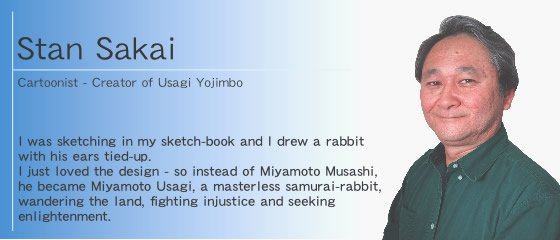 |
| —— Stan, could you tell us a little bit about your background? Well, first of all, I'm a 3rd generation Japanese-American, sansei. Both my older brother and myself were born in Kyoto, but we grew up in Hawaii. ハMy dad was from Hawaii and he was stationed in Japan after the war, that's where he met my mom, who was originally from Nagasaki. I remember going back and visiting Tezuka Osamu Productions in Kyoto and stopping by a nearby shrine, when I told my mom she said, "Oh yeah, you were born right around the corner from there!" Anyway, we eventually moved back to Hawaii and right down the street from where we lived was an old movie theater, the old Kapahulu Theater. They showed the "chambara" movies every Saturday and so I'd go every week. Admission was only a quarter! I used to watch old Toshiro Mifune movies, the Kurosawa flicks, "The Seven Samurai", all of them. My favorite was 3-parter called "Sotomi Hakkenden", directed by Uchide Kokichi. I wish I had a copy of the original. I have two versions, but the one I'm looking for was made in 1959 that's the one I grew up on. —— Did you always know you wanted to be an artist and draw comics? I've always loved drawing, ever since grade school, and comics. When I was a kid, I drew whenever I could. In school I was one of the class artists. At Kaimuki High, I took my first art course in the 11th grade and later I continued my studies, majoring in Fine Arts at the University of Hawaii. My parents, Japanese parents, always warned me, "You can't make a living as an artist." They wanted me to get into computer programming or accounting. My dad was an accountant and would always tell me, "I can get you a job at the hotel." Before I had any success in comics, I was doing freelance work and in the beginning it was tough. I was doing commercial art, advertising, book illustrations, record album covers and that sort of thing. I thought hoped that maybe I could do comics as a part-time thing something I could do along with my commercial work. Then Usagi came along and comics just took over. 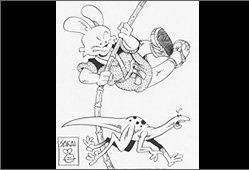
Jotoro and one of Stanʼs dynamic dinosaurs trying out for the Olympics?
Actually, I think it happened after the first book signing I did in Hawaii. I had been living on the mainland for a few years, freelancing in California, when my comic Usagi Yojimbo came out. Things were going pretty good and a bookstore in Hawaii called and invited me to come back and do a book signing. My dad was thinking he'd stop by to see me there, I'm sure he didn't think it would be too crowded, but he couldn't get into the store because the lines were so long! I think that's what turned him around. —— As a kid, what were some of your favorite comics and influences? Oh Spiderman! I loved Steve Ditko's work and the Fantastic Four! I grew up reading all the old Stan Lee-Jack Kirby material and now I actually work with Stan Lee. I've been doing the lettering for the Spiderman newspaper strips for 20 years. It's been a thrill for me, because Stan Lee was the first name I associate with the comic would. And then to get to work with him!! He called me on the phone one day and says, "Hey Stan this is Stan Lee, I need a letterer why don't you come on down?" He's just like the ways he's portrayed; he's very exuberant and has a lot of energy Stan the Man. He's such a neat guy. I had mentioned to Stan once that my son really likes the Marvel characters and the next day UPS came with a big box of toys and things. You know, one of the best things about my work is that many of the people that I was a fan of growing up I work with or are my friends. People like Will Eisner, Lynn Johnston and Sergio Aragon. Sergio is one of my best friends and another of my childhood heroes. He's probably most noted for his work on "Mad" magazine. He's been in every issue of Mad since 1964, and we work together now on his comic "Groo the Wanderer". He's just a great guy I really love him. I've always liked the characters that have a human side to them flaws. Usagi has lots of flaws and he has to deal with them as he walks the "shugyosha" or the warrior's path of learning. I think that's what makes them interesting. 
A more serious side to Miyamoto Usagi.
Well, I grew up watching samurai movies and reading comic books, so I was always a fan. I actually wanted to draw superheroes, but I was exploring doing a samurai story. I was thinking I'd like to do a series based upon the life of Miyamoto Musashi, an actual 17th century samurai, and one day I was sketching in my sketch-book and I drew a rabbit with his ears tied-up. I just loved the design so instead of Miyamoto Musashi, he became Miyamoto Usagi, a masterless samurai-rabbit, wandering the land, fighting injustice and seeking enlightenment. It's not like a light bulb just went on over my head it wasn't that simple, but I loved the idea and once I started drawing Usagi the path was set for me. Actually, a lot of the characters I've created for the Usagi series are based on historical characters. —— What do you draw upon for some of your story lines? Everything and everywhere! Where do ideas come from? I mean Usagi came from a sketch I did so sometimes they come from my sketching or from reading, maybe TV just about anywhere. I read a lot and I have a pretty big library of books on Japan and Japanese folklore. I also watch a lot of TV I love documentaries, and I even get to watch some Japanese TV. So ideas can come from anything. In spite of my being Japanese-American and growing up in Hawaii, which has a strong Japanese influence, it's still one step removed, so I have to do a lot of research for my stories and that research has to be learned, simply because I've never lived in that era or culture. I try to make the stories it as authentic as I can within reason. There are a few minor things that I take artistic license on, but as far as the big things the code of the samurai, bushido etc., I try to get it as accurate as possible. I also try to include story notes and a bibliography along with my stories whenever I can. 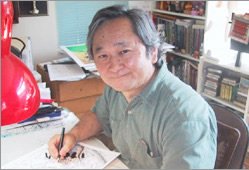
Stan hard at work putting together another of Usagiʼs fabulous.
One of my favorite stories is "The Kite Story" and that came about after I bought a book on Japanese kite making. About 3 years later I did a sketch of Usagi flying a kite and I thought it would be nice to have Usagi at a kite festival. So I did a bit more research and started, but it actually took years to complete. In that story I tell the tale of a certain province's actual kite-festival in which the Lord of that province had ordered an irrigation canal to be built. After it's completion, he then ordered a day of kite flying a festival. He gave the people a day of relaxation, but also knowing that all those feet running up and down the banks of the canal, flying their kites, would stomp it into a more solid embankment. I thought that was marvelous, so I used that as part of the story. I also conveyed the entire process of making O-tako, the giant forty-foot kites from making the paper to seasoning the bamboo and so on. During the festival the gamblers would come to town to fleece all of the festival lords and then of course Usagi comes to town. It was a complicated story told from 3 perspectives: the kite maker's, the gambler's, and Usagi's. In the end the town's people chased out the gamblers, and the gamblers chased out Usagi with Usagi making his great escape on one of the giant kites. It was so much fun, but the hardest part for me was figuring out how the gamblers cheated back then. There are lots of books on kite making, but there aren't so many on the seedier sides of Japanese society. That's were things like those old Zatoichi movies come in they serve to give me a little insight. —— I can hear it in your voice…Usagi isn’t just your job. Oh no! I love working on this idea and I'm so very grateful because I get to do what I really love. I've got ideas for storylines for the next ten years right now, it's just what's going to happen next month that I'm never quite sure about! My studio is at my house so when my kids were little, I was the stay at home parent. My kids grew up on my lap, watching me draw, and a lot of my pages actually have their drawings on the back too! —— Sounds like a dream come true for the kids, having a cartoonist for a father. I don't think so, but it's hard to say. I think to them I'm just the way I am. Someone once asked Hannah, my daughter, "What's it like being Stan Sakai's daughter?" and she said, "He's just dad!" They really have nothing else to compare it to, so for them it's nothing unusual. 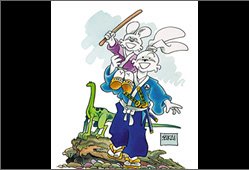
Usagi with Jotoro on his shoulder starting out on a new adventure.
Yes. First of all getting the idea where do ideas come from? When I get one though, I write it down and make a one or two page outline of a rough story with a beginning, middle, and end. I may use some patches of dialogue with some descriptions of action and then I do thumbnails. Thumbnails are little rectangles, a few inched longノvery rough stick figures actually, and then I write the dialogue on the side of thumbnails. From there, I do the pencils and I find that works for me. I'm always developing. I think every artist keeps developing and over the last 20 years my characters have grown and changed too. Most of it is unconscious on my part, but I think it has had to do with my own growth as an artist, person and a storyteller, and the fact that, well, Usagi seems to take on a life of his own. —— Do you find you get into character when you are writing and drawing Usagi? No, no, no (laughing). I love Usagi but he's not that much of a person to me. I've heard some people do that seeing things through their characters eyes. Maybe, I could if I didn't have to work so hard at writing and drawing his adventures. —— On the business side of things, your an independent, rather than working for one of the major publishers, what do you like about that? Working on an independent comic gives me total control of all aspects of the creative process, which can be good and bad, but it suits me. It gives me the freedom to tell a story whichever way I see fit and the only limitations are the ones I place upon myself. From talking with artists in other fields, even in mainstream comics, it seems their creative vision is sometimes compromised due to various factors. Here I have complete control to do as I like and I'm grateful that readers have responded to that. The fact that the people I work with are really great helps a lot too. —— I know you have created some different takes on Usagi like Space Usagi, do you have any plans for others? Well, Space Usagi is actually a futuristic descendant of the original Usagi Yojimbo. He came about because I like to draw dinosaurs. I like to draw Usagi too so I figured I could do both by either going back in time, to prehistoric times, or by going to the future and visiting a dinosaur planet and that seemed like much more fun to me. —— Do you ever imagine Usagi coming to spend some time in modern-day Japan? No (laughing)! Actually, I probably know ancient Japan better than anything in modern-day Japan. I did once create a 21st century descendant of Usagi though she was a female investigative reporter. 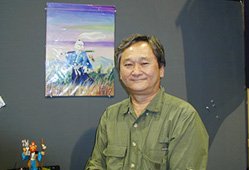
Stan and his creation at his 27th San Diego Comic-con.
Well, this season Usagi will be appearing on the TV series the "Teenage Ninja Mutant Turtles" again. He's in four episodes called the "Big Brawl". He'll also be appearing next season too, along with his entire cast of supporting characters from the comic. One of the Ninja Turtles, Leonardo, goes to Usagi's world and they get blasted to another world. Generally, these stories are not really part of Usagi's continuity that's created for the comic, but they're great fun. There will be some new toys coming out too and there is going to be an "Art of Usagi Yojimbo" hardcover coffee-table book coming out. It's going to be 200 pages and will have a very nice color section. What's really exciting for me is there will be section done all by guest artists Usagi drawn by people like Sergio Aragon and Frank Miller, among others. —— Have you ever thought about doing an Usagi movie or TV series? You know, we get calls every so often from studios for a movie or a TV series and some of them are very interesting. Some, one in particular, I was very disappointed that it did not happen, but most of them well, all of them are interesting, but I think we just haven't connected with the right producers yet. —— I’ve heard that while Usagi is popular all over the world, but he’s not that big in Japan, considering his samurai roots, isn’t that a bit ironic? Well, there has never really been an American comic book that has made even a dent in the Japanese market. They did have some of the Marvel comics that were remade for the Japanese market, but nothing has ever left a lasting impression. Funny, but where Usagi does really well is in Europe. People from all over Europe really love him and he's been published in about 10 different languages, including Polish and Croatian. —— So Usagi is fluent in quite a number of languages then? He speaks more languages than I do. In fact, I'm going to Poland this October and later this year, in mid-November, my wife and I are going to Spain. —— Work, right? Oh yeah! (laughing) We're guests of some great festivals, so it's work and a lot of play! I love to travel, so this is just great. (10-01-2004 issue, Interviewed by Terry Nicholas) |

